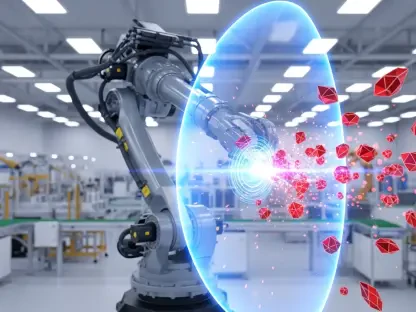In the ever-evolving landscape of cybersecurity, the manufacturing sector finds itself at the forefront of a relentless battle against sophisticated cyberthreats, with ransomware attacks and data breaches becoming alarmingly common. Recent reports indicate that this industry accounts for nearly 28% of global ransomware incidents, positioning it as the most targeted sector worldwide. Traditional security measures, once considered robust, are increasingly inadequate against the cunning tactics of modern cybercriminals who exploit vulnerabilities with AI-driven precision. As operational disruptions and data loss threaten to cripple production lines and supply chains, the urgency to adopt innovative solutions has never been greater. Behavioral analytics emerges as a promising ally in this fight, offering a proactive approach to detect anomalies and mitigate risks before they escalate into full-blown crises. By focusing on patterns of user and network behavior, this technology provides a critical layer of defense that could redefine how manufacturers safeguard their digital assets.
Rising Cyberthreats in the Manufacturing Sector
The manufacturing industry has become a prime target for cybercriminals due to its high stakes and interconnected systems, where even a brief disruption can lead to staggering financial losses. According to recent data from IBM’s X-Force Threat Intelligence Index, ransomware attacks on industrial sectors have surged by 50% over recent years, with no signs of slowing down. These attacks often exploit outdated security protocols and the growing complexity of hybrid work environments, where remote access points create new vulnerabilities. The pressure to maintain uninterrupted operations often forces companies to pay hefty ransoms, further incentivizing attackers. Beyond external threats, internal risks also loom large, as disgruntled employees or compromised credentials can lead to devastating breaches. This persistent targeting underscores the need for adaptive security measures that go beyond static defenses and address the dynamic nature of today’s cyber landscape, setting the stage for more intelligent solutions.
Compounding the challenge is the rapid adoption of cloud technologies and SaaS platforms, which, while enhancing efficiency, also decentralize data and expand the attack surface for manufacturers. Cybercriminals are quick to exploit misconfigurations or weak access controls in these environments, often gaining unauthorized entry before traditional systems can raise an alarm. The Verizon Data Breach Investigations Report highlights that 18% of breaches involve internal actors, a statistic that reveals the hidden dangers within organizations. These internal threats are particularly insidious, as they often go undetected by conventional perimeter-based tools designed for external attacks. The convergence of external sophistication and internal vulnerabilities creates a perfect storm, demanding a shift toward security strategies that prioritize real-time monitoring and anomaly detection. Manufacturers must adapt to this reality by embracing technologies capable of navigating the complexities of modern, dispersed workforces.
The Power of Behavioral Analytics in Threat Detection
Behavioral analytics stands out as a transformative tool for manufacturers by establishing baselines of normal activity across networks and user interactions, thereby enabling the swift identification of deviations that could signal a threat. Unlike traditional signature-based systems that rely on known attack patterns, this technology focuses on subtle anomalies—such as unusual login times or unexpected file access—that might indicate a breach or insider threat. By continuously learning and adapting to evolving patterns, it offers a dynamic defense against both known and unknown dangers. This capability is especially crucial in manufacturing, where the cost of downtime can be catastrophic, and early detection can mean the difference between a minor incident and a major crisis. The ability to spot potential issues before they escalate provides security teams with a vital window to act, reducing the likelihood of operational interruptions or data loss.
Moreover, behavioral analytics enhances response agility by automating the recognition of suspicious behavior, thus alleviating the burden on overworked security personnel. In an era where cyberthreats are increasingly stealthy, manual monitoring alone is insufficient to keep pace with the volume and sophistication of attacks. This technology integrates seamlessly with existing systems like endpoint protection and SIEM platforms, creating a layered defense that strengthens the overall security posture. For instance, when an employee’s account exhibits abnormal activity, such as accessing sensitive data outside regular hours, behavioral analytics can trigger immediate alerts for investigation. This proactive approach not only minimizes damage but also empowers teams to focus on genuine threats rather than sifting through countless false positives. As manufacturing environments grow more complex with IoT devices and cloud integrations, such intelligent monitoring becomes indispensable for maintaining robust cybersecurity.
Building a Resilient Future with Adaptive Security
The integration of behavioral analytics into cybersecurity frameworks marks a significant step toward building resilience against the ever-changing tactics of cybercriminals targeting manufacturers. Its ability to operate effectively across diverse environments—whether on-premises, in the cloud, or within hybrid setups—makes it uniquely suited to address the decentralized nature of modern operations. By providing cross-environment visibility, this technology ensures that unauthorized access or data exfiltration is detected in real time, regardless of where the threat originates. This adaptability is critical as attackers increasingly leverage advanced tools like AI to craft tailored attacks that evade traditional defenses. For manufacturers, adopting such forward-thinking solutions is not just a matter of staying ahead of threats but also of protecting the integrity of supply chains and customer trust, which are often irreparably damaged by breaches.
Looking ahead, the trend of escalating cyberthreats underscores the necessity of combining behavioral analytics with other security measures to create a comprehensive defense strategy. The continuous evolution of attack vectors means that no single solution can provide complete protection, but a multi-layered approach can significantly reduce risks. Security teams are encouraged to explore how this technology can complement existing tools, enhancing their ability to anticipate and neutralize threats before they cause harm. Additionally, investing in employee training to recognize phishing attempts and secure access protocols can further bolster defenses. As the manufacturing sector navigates an increasingly hostile digital landscape, embracing innovative technologies like behavioral analytics will be key to safeguarding critical operations. The journey toward cyber resilience is ongoing, and staying proactive with adaptive solutions remains the most effective way to counter the sophisticated dangers of today and tomorrow.
Reflecting on a Path Forward for Cybersecurity
Reflecting on the strides made in combating cyberthreats, it becomes evident that behavioral analytics has reshaped the approach manufacturers take to protect their operations from relentless digital adversaries. Its implementation has proven instrumental in identifying risks early, allowing companies to thwart potential breaches before they inflict severe damage. Security teams have witnessed firsthand how automated anomaly detection reduces response times, enabling them to address genuine threats with precision. The integration with existing systems has also fortified defenses, creating a robust shield against both external attacks and internal vulnerabilities. As the industry has grappled with a 50% surge in ransomware incidents, this technology has offered a lifeline, ensuring that even the most cunning attacks are met with swift countermeasures. Moving forward, manufacturers are urged to prioritize such adaptive tools, invest in ongoing training, and foster a culture of vigilance to sustain resilience against evolving cyber risks.









